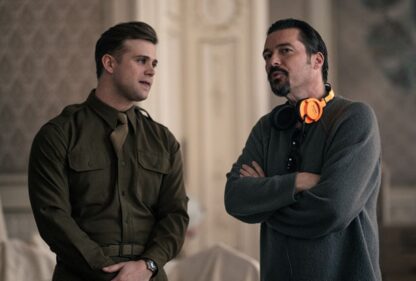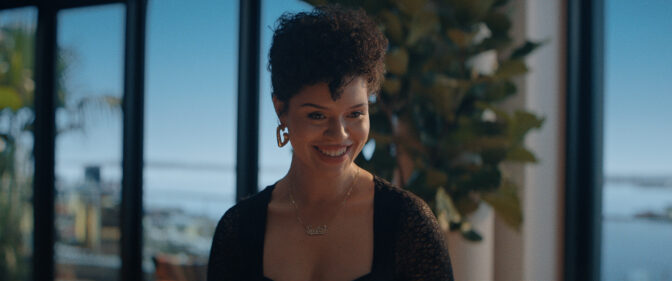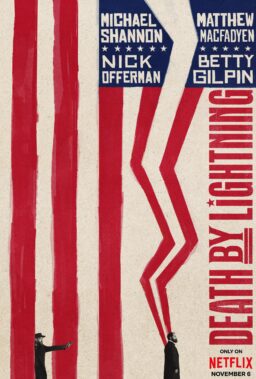It is an interesting moral equation, Steven Spielberg was saying. When three brothers in the same family are all killed during World War II, the Army chief of staff promises their mother that the fourth brother will be brought home alive. Then he orders an eight-man squad to go out and get him. The men must penetrate terrain still being violently contested by the Nazis.
“So what you’re doing,” Spielberg said, “is sending eight people out, all of whom have parents, to rescue one boy and send him back to his mom when any or all of these kids, along the mission route, could be killed. That was the central tug that made me want to tell the story.”
Simple, ironic math. But “Saving Private Ryan,” Spielberg’s new film, raises it to another order. If the movie had been made in 1944, he agreed, the film would have ended with Ryan being found, and saved, and brought back for a reunion with his mother. Spielberg’s film doesn’t make it that simple.
“There was a sentiment that Hollywood put out there in the 1940s,” he said, “when they cooperated with Roosevelt to make movies extolling the virtues and nobility of the war. They would never have allowed the story to be told this way. They weren’t willing, in those days, to show America the dark side of the face of war.”
So is Spielberg’s revisionist story an anti-war film? Not at all. It accepts the necessity of their war, and its heroes reject the easy symbolism of saving Ryan, and confront what they are really there for, which is to kill enemy soldiers and win the war and try not to get killed themselves.
Is this you, I asked Spielberg, remembering the war movies you saw as a kid, and wanting to make one that was less upbeat, that wasn’t locked into a formula?
“This is me being 51 years old and my dad being 81, and he fought in Burma,” he said. “And my wanting to acquit his war with honor, as opposed to just using his war as the backdrop for a big action adventure picture.”
The story really begins when the squad, led by Tom Hanks, finds Ryan (Matt Damon). At that point, they all – the searchers, the private, and the men he’s fighting with – have to decide what to do next. Ryan and his group are defending an important bridge. If he stays, he’s making a simple statement: The war is worth fighting, and it’s worth dying for.
“Saving Private Ryan” is a film that means a lot to Spielberg, who brought along his star, Tom Hanks, on a visit to Chicago to talk about it. When the historians look back over his career, they’ll find, I suspect, that his films fall into two categories: The great popular entertainments that he seems to make with natural ease, and the more difficult, tricky films that he slips in between them. “Saving Private Ryan” goes on the list with titles like “Schindler's List,” “The Color Purple” and “Empire of the Sun.” The dinosaurs of Jurassic Park occupy other spheres of his talent.
He is the most successful filmmaker of his generation, and perhaps of any generation. No one has made movies seen by more people, and yet at his best Spielberg is more than just popular; he has the spark of the artist. In “Saving Private Ryan,” he takes genre material and rotates it until it reveals its truthful, difficult side. Beneath the action and the wartime dialogue is an unblinking acceptance of the nature of war.
Part of that rotation turns away from traditional action heroes and toward the kinds of soldiers who actually did fight the war: not John Wayne, but English teachers from Pennsylvania, and Iowa farm boys. In casting Tom Hanks as his lead, Spielberg smiled, “I was trying very hard to imagine what actor would not immediately want to use his teeth to pull out a pin from a hand grenade. And Tom Hanks just sprung to mind.”
Matt Damon, who plays Ryan, is a star after “Good Will Hunting” and other titles, but when Spielberg cast him, he’d only seen him in “Courage Under Fire.”
“Robin Williams introduced us. I thought he had a great American everyboy look, and he was also a fine actor. Who knew he was gonna go off and become a movie star overnight and win the Academy Award for screenplay? And not be the anonymous actor I had in mind? But he looked the part. You know, the people in World War II actually looked different than people look today. A lot of the people I cast in this picture, I was looking at their faces, to match the faces I saw on the newsreels.”
How do we look different now?
“We look more innocent. In those days, all the boys looked like men.
“Today boys 17 or 18 years old look like children, but back then, the 16-, 17-, 18-year-old face actually looked sometimes like a 29- to 35-year-old face. If you look at all those guys coming down the gangplanks in the documentary footage, they all look much older than they actually were.”
The movie stars back then, too, I said. Robert Mitchum never looked young. He always looked 40, until he started looking 60. Is there something in our society that created that difference in perception?
Spielberg grinned. “Bottled water! I don’t know what it is. I think in the 1940s we looked a lot more like our ancestors who came over on ships to settle here from other countries. Today, the one country that still has faces from the 1940s are the Australians. Australian boys look as grown up as the boys looked 50 years ago.”
It’s true that his cast, for the most part, looks weathered and beaten. Only the timid young translator, who speaks German and French but has never fired at anyone, looks like a kid. And what happens inside him, by the end of the movie, is one of the story’s most unblinking messages.
Looking at the film, you can see how physically and mentally demanding it must have been, especially in the combat scenes as waves of landing craft hit the beaches and many soldiers are massacred by Nazi machineguns before they even get their feet wet. The haggard exhaustion on the faces of the actors in some shots cannot simply be acting.
“It was a mentally demoralizing experience for us,” Spielberg said, “because we shot in continuity, from beginning to end. We were all reliving the story together. The last film I shot in continuity was ‘E.T.’ I did that to help the kids understand where they were coming from and where they were going in the story. So literally yesterday was a page ago and tomorrow would be a page later.
“I did that again in this picture but I didn’t realize how devastating that was going to be for the whole cast to actually start off with Omaha Beach and survive that as a film team, and then move into the hedgerows, move into the next town, as we all began to get whittled down by the storytelling.”
You held a boot camp for these guys. Did you go through it yourself?
“No. One of the gratuities about being a director is that you can volunteer yourself out of difficult details. I didn’t do the boot camp but they had to. It was, but much shorter. A regular soldier does four months of boot camp and these guys did six days. But I wanted to put them through boot camp not just to familiarize them with how to hold a weapon and how to clean and fire it – but because I wanted them to respect what it was like to be a soldier.”
We sense that reality in the extraordinary opening sequence, as landing craft arrive at Normandy Beach to find the Nazi resistance much fiercer than predicted. Those who got ashore walked over dead bodies. Most of them had never been in combat before. One has his arm blown off and stoops over to pick it up, as if he’ll need it later. It was a bewildering, terrifying hell. Usually war pictures break down into individual acts of action or heroism. Here we see waves of helpless soldiers mowed down. In the landing crafts, before they arrive at the beach, we see them vomiting and shaking and praying: not the vision Hollywood offered in the 1940s.
“You see it the way it was,” Spielberg said. “It’s easy to point out a couple of shots that are obviously very graphic, but it’s the accumulation of the sequence on Omaha Beach that’s supposed to help the audience understand the physical experience of combat. I didn’t want to do something I’ve done with many of my other movies – allowing the audience to be spectators. Here I wanted to bring the audience onto the stage with me and demand them to be participants with those kids who had never seen combat before in real life, and get to the top of Omaha Beach together.”
As we approach the end of the century, I said, I’ve been thinking that it’s the first century that has been recorded on film, in fact and fiction. And a film like this deals with the key event of the century.
“I think it is the key – the turning point of the entire century. It was as simple as this: The century either was going to produce the baby boomers or it was not going to produce the baby boomers. World War II allowed my generation to exist.”
World War II made our future possible.
“The baby boomers owe a big debt of gratitude to the parents and grandparents – who we haven’t given enough credit to anyway – for giving us another generation.”
That’s me, too.
“That’s you, too. And me.”











